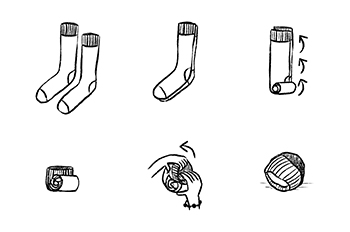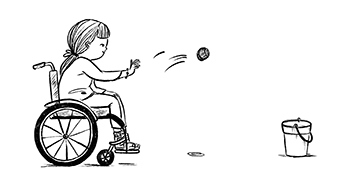Sock ball games: why they’re good for children with disability, autism or other additional needs
Sock balls are soft, small, catchable balls made from pairs of socks. Children can play many different games with sock balls. Children can use one or more balls, and they can play on their own or with others.
Sock ball games can help children with disability, autism or other additional needs develop hand-eye coordination and motor skills. These games also encourage teamwork and help children connect with others.
Sock balls are easy to catch. Catching sock balls is good for children’s confidence and sense of achievement. And because they’re soft and squishy, sock balls are unlikely to damage things or injure people.
Sock ball games can be good for children at stressful times. This is because sock ball games can distract children from things that are worrying them. Also, children can squeeze sock balls, which can help them relieve stress.
What you need for sock balls
You need 2 socks to make one sock ball. They can be socks of different sizes and materials.
Depending on the game your child wants to play, you might also need:
- a target – for example, a bucket or a pillow on the floor
- a ramp – for example, a small table raised at one end or a piece of cardboard
- a soccer ‘goal’ – for example, a couple of items of clothing placed a short distance apart.
How to make sock balls
Here’s how to make sock balls with your child:
- Take 2 socks.
- Stuff one sock inside the other and push it deep into the toe.
- Tie off or twist the ankle of the sock you’re holding, to make a ball shape out of the stuffed toe.
- Fold the top of the sock back over the ‘ball’ part of the sock.
- If you’re using long socks, keep twisting and folding back until you’ve used up all the sock.

Games to play with sock balls
Throwing and catching
- Encourage your child to throw and catch the sock ball in the air. As your child gets better at throwing and catching, get your child to try throwing higher.
- Set up a throwing and catching game with other children. Children could start close together and take a step back each time one of them catches the ball. It might be fun for the children to see how far they can go before someone drops the ball.
Target games
- Set up a target on the floor. It could be a bucket or a piece of clothing. Get your child to start close to the target and ask them to try to hit the target with the sock ball. As your child gets better at hitting the target, get them to move further away from the target or make the target smaller. Or you could move the target to a different height, like on a chair or table. Ask your child whether they find it harder or easier to hit the target at the new height.
- If you’re playing with your child, take turns trying to hit the target. You could set up a points system – the further away you are when you hit the target, the more points you score. Or you could score more points if you can hit the target with your eyes closed.

Rolling
- Set up a ramp using a box, a small table raised at one end, or a piece of cardboard. Get your child to see how fast or far they can roll their sock ball down the ramp. Your child might like to see what happens if they adjust the height of the ramp.
- Get your child to try rolling the sock ball down different parts of their body.
You and your child might enjoy making up your own sock ball games. You could look around you to see whether there’s anything you could use in your game. Or perhaps you could make up a scoring system or keep the game going over several days.
How to adapt sock ball games to suit children with diverse abilities
Although sock balls are easier to hold and handle than other balls, children who have difficulty with fine motor skills might need you or another carer to help them handle the ball. You can also try pushing or rolling the ball to each other rather than throwing and catching.
If children can’t use their hands, they can push, knock or roll the ball with other body parts, like their nose, elbows or feet.
For children with vision impairment, try putting something that makes a sound inside the sock ball – for example, bells, keys or coins. Make sure the objects are covered enough so that the ball doesn’t have any hard or sharp edges.
Children with autism or learning difficulties might need you to repeat the steps during the game. Also they might need to use a pen and paper to keep score, rather than keeping score in their heads.
Looking for more play and learning ideas for your child? You might like to explore our other activity guides. Some of these have been created for typically developing children, but they can all be adapted to suit children with diverse strengths and abilities.